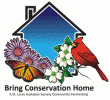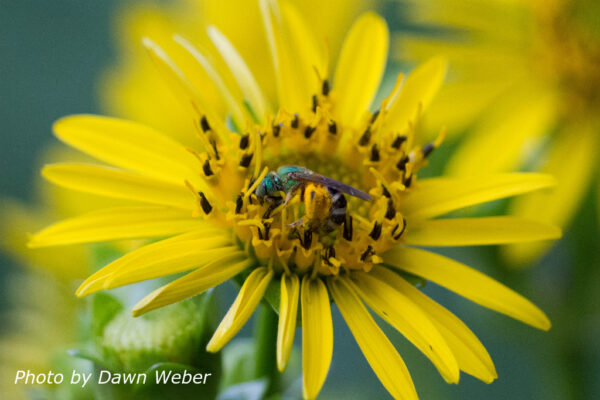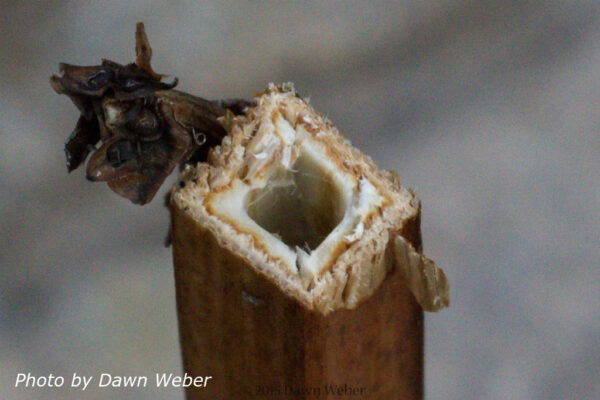By Cori Westcott
for Bring Conservation Home
 Someone told me
Someone told me
It’s all happening at the zoo
I do believe it
I do believe it’s true – from Paul Simon’s At the Zoo, 1968
When I think of the potential for a bustling natural winter community that may be happening in stems of my cup plant (Silphium perfoliatum) during the winter, Simon’s song cycles through my mind.
Wisconsin entomologist Andrew H. Williams collected (1996) and identified (1997) more than twenty species of insects and spiders overwintering in Silphium perfoliatum stems. In February, Mr. Williams sent a copy of his table on discovered insect and spider collections from cup plant stems in Grant County, Wisconsin to me upon request. He graciously has given me permission to share his findings with you.
Mr. Williams’ findings are listed by taxon. I’ve done a little research to further identify the insects and glean any special behavior to pass along. I’m about to share some intriguing behavior of the cup plant’s winter residents in a rapid-fire style Mr. Simon used in describing the zoo’s citizen’s. Cue Simon’s song…
Many of the cup plant stem insects are entomophagous (larva which consume their hosts). The movie, Alien, wasn’t original, you know. Braconid wasps are entomophagous, too. Like a chalcidoid, a braconid wasp larva starts as an egg that hatches in the host insect. The host itself intended to overwinter in the cup plant stem. After emerging from the host, some braconid larvae overwinter in the stem.
Mr. Williams found the following insects.
- Gall midge (Camptomyia sp.): Some fungus-eating gall midge larvae exhibit a reproduction phenomenon called paedogenesis, “…in which daughter larvae are sometimes produced inside mother larvae, eventually consuming the mother.” (p. 393)[1]
- In startled launch, the tumbling flower beetle (Mordellistena convicta) has a tumble caused by his habit of pulling in his legs.
- Did you know booklice didn’t eat the book? They ate the mold that ate the book. Lachesilla corona are members of the Psocoptera (meaning gnawed or rubbed wing) order, booklice, and plantlice.
- Plant bugs of the Miridae family inject enzymes to turn pant tissue into a Slurpee and sip it up through their “beaks”.
- Also, Mr. Williams and his colleagues identified a mite or tick, a cicada, a Silphium borer moth larva, a checkered beetle, a katydid, a featherwing beetle (usually <1mm), and others. All of these are food sources for birds and other wildlife.
I have great fondness for a plant that defies the common patterns of nature by displaying a square stem. It gets its name from the supply of water it keeps at the base of its joined leaves that serves as a public water source for birds and small mammals. Once, I bumped a cup plant and inadvertently drenched my poor husband!
After the abundant pollinators are finished, the seeds provide a much needed food supply to American goldfinches. Although their brilliant yellow color is waning at this time, it still can be a spectacular sight.
So, when its glory has past, its leaves curled and brown, consider cutting it in foot-long sections and simply leave it on the ground. Its winter residents will find it and still be happy to reside in a horizontal rather than a vertical home. Also, you can bundle up some, hollow out the ends’ tips on one side, and store somewhere the solitary bees can find them for shelter. The plant serves a natural service year round!
Watch pollinators visiting my Silphium perfoliatum.
[1] Marshall, Stephen A. (2006). Insects: Their Natural History and Diversity. Buffalo, NY: Firefly Books.
Cori Westcott is president of Missouri Master Naturalist, Great Rivers Chapter. She serves as a Habitat Advisor for St. Louis Audubon Society’s Bring Conservation Home. She coordinates monitoring efforts in the Grand Glaize Creek watershed for Missouri Stream Team.




I made a bundle of cup plant stems and hung it on my front porch. It has attracted grass wasps which stuff grass into the tube after they lay an egg. Some tubes are walled off with mud. I am not sure what is in there yet.
This years cup plant stalks are still standing in the yard.
My bundle was put together from the plants I cut down in the Spring last year.
The eggs were laid in the bundled tubes over the summer and fall of 2015. So I assume there are insect larva in my standing tubes too. If you need to cut them down in the Spring, lean the dry stalks up against a fence or wall so whatever is in there can come out when they are ready.
I grow a whole stand of cup flower about a 40′ section behind a fence and leave it up till spring . Southern Illinois zone 6b. Got my start from the field ditch across the street , township
Keeps it mowed and never gets to bloom in the last 5 years .